Quantifying the Unwinding Due to Ram Pressure Stripping in Simulated Galaxies
Abstract
1. Introduction
2. Simulation
3. Analysis and Results
3.1. Global Evolution
3.2. Amplitude and Location of the Asymmetries
3.3. Direction of the Elongation
3.4. Shapes of the Spiral Arms
4. Discussion
5. Conclusions
Author Contributions
Funding
Data Availability Statement
Acknowledgments
Conflicts of Interest
Appendix A. Isolated Galaxy
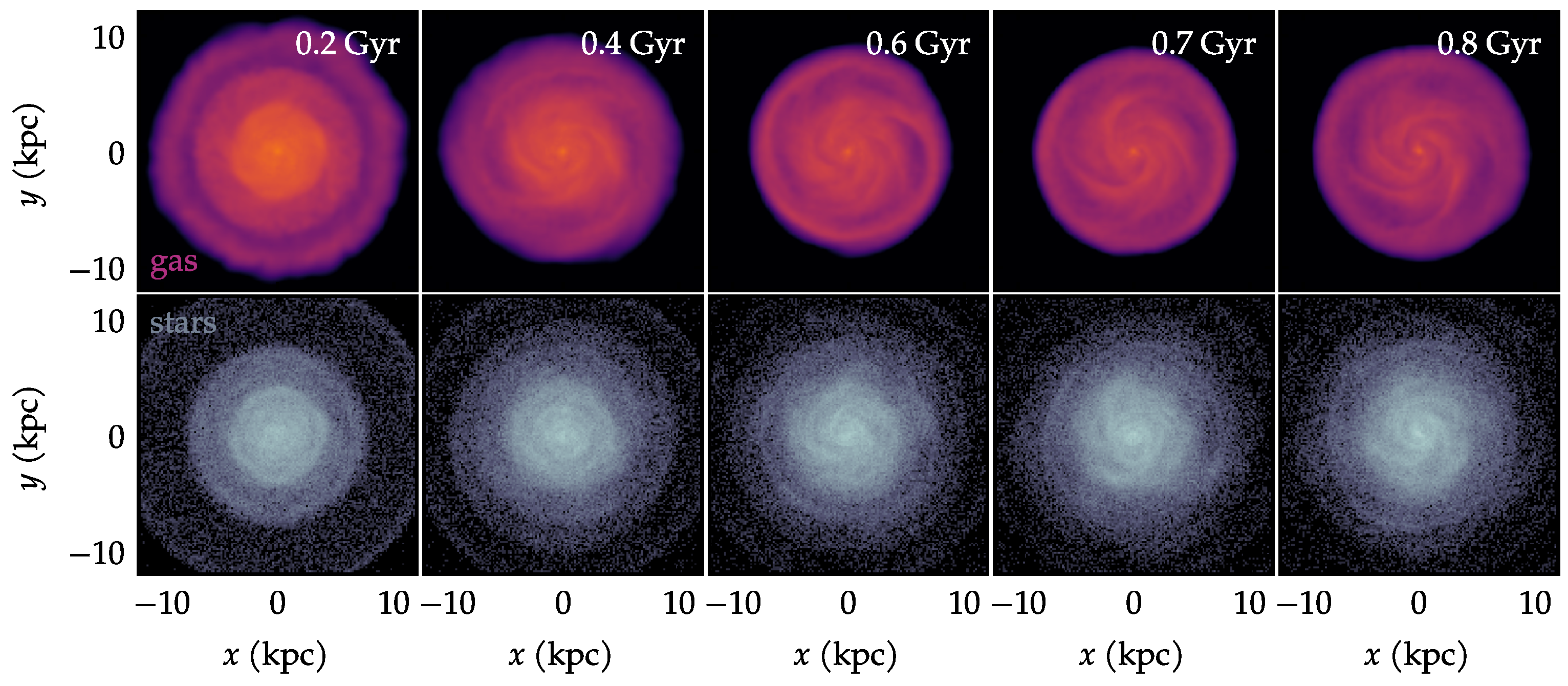
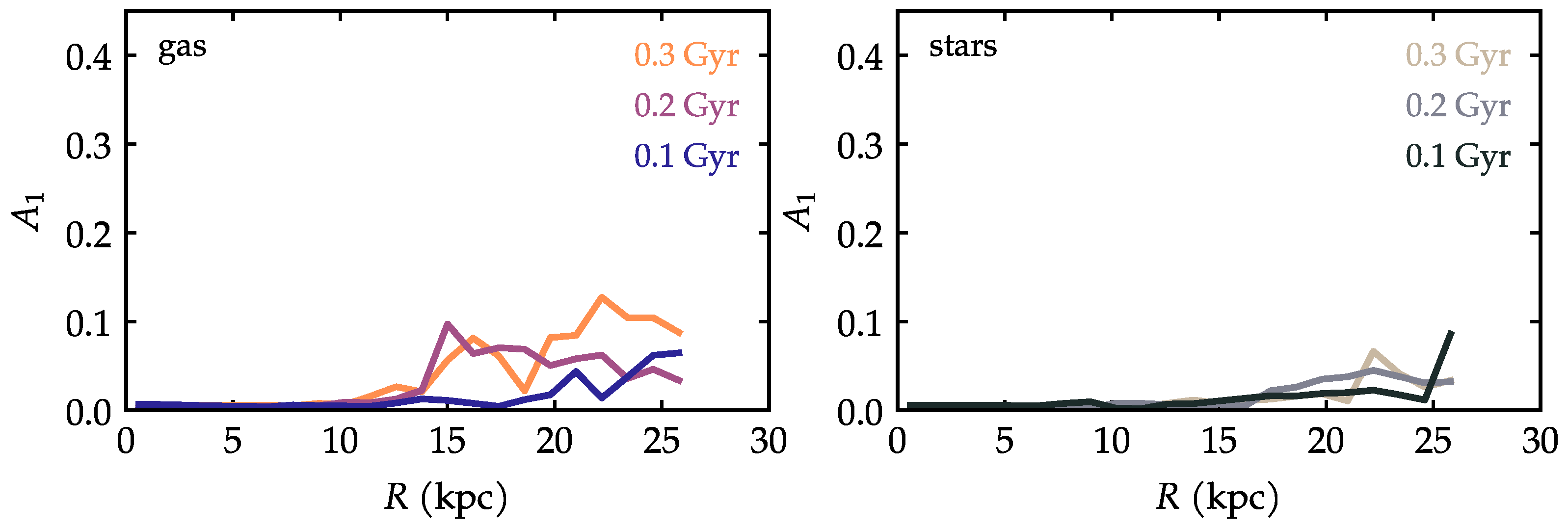
Appendix B. The Radon Transform
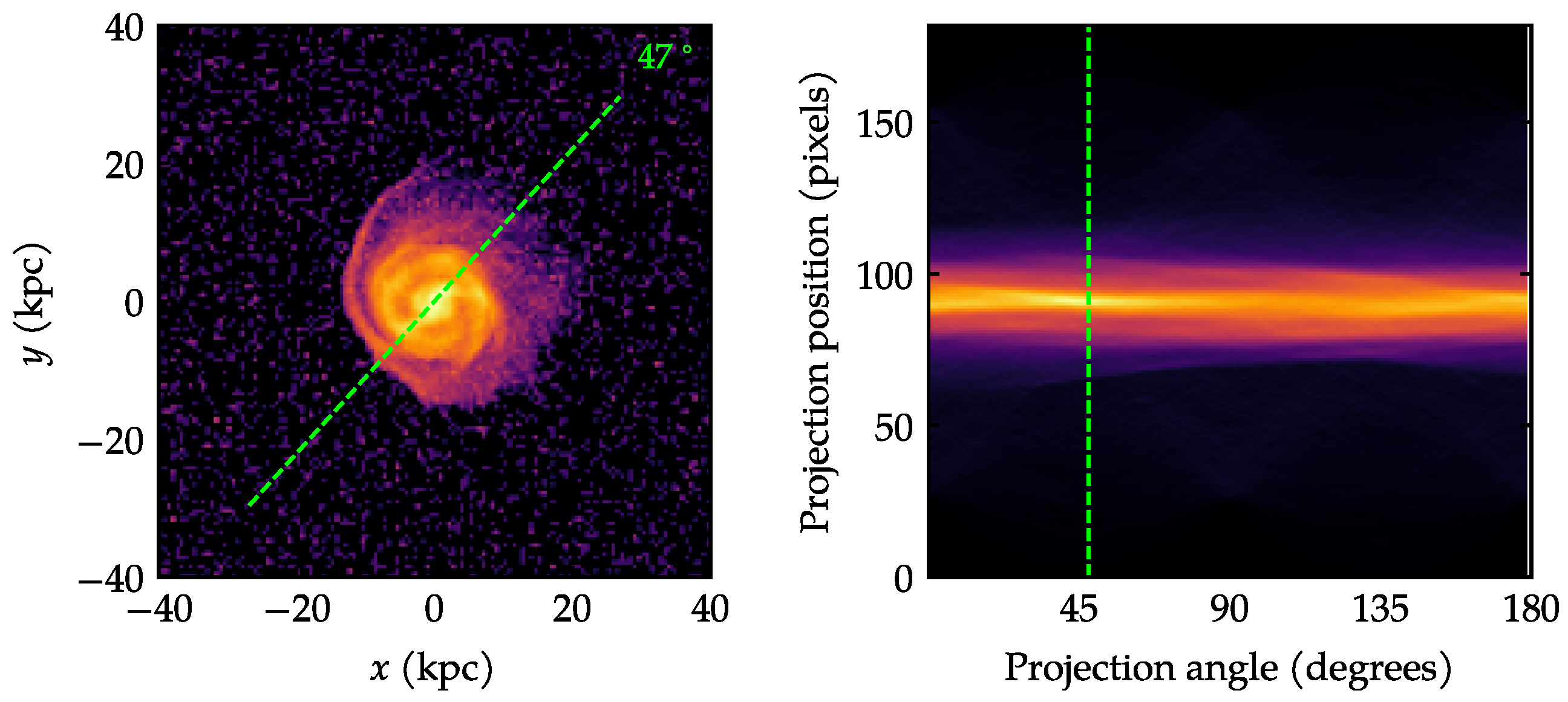
| 1 | https://github.com/elvismello/galstep (accessed on 25 May 2025). |
| 2 | https://github.com/elvismello/clustep (accessed on 25 May 2025). |
References
- Gunn, J.E.; Gott, J.; Richard, I. On the Infall of Matter Into Clusters of Galaxies and Some Effects on Their Evolution. Astrophys. J. 1972, 176, 1. [Google Scholar] [CrossRef]
- Boselli, A.; Fossati, M.; Sun, M. Ram pressure stripping in high-density environments. Astron. Astrophys. Rev. 2022, 30, 3. [Google Scholar] [CrossRef]
- Poggianti, B.M.; Moretti, A.; Gullieuszik, M.; Fritz, J.; Jaffé, Y.; Bettoni, D.; Fasano, G.; Bellhouse, C.; Hau, G.; Vulcani, B.; et al. GASP. I. Gas Stripping Phenomena in Galaxies with MUSE. Astrophys. J. 2017, 844, 48. [Google Scholar] [CrossRef]
- Gullieuszik, M.; Poggianti, B.M.; Moretti, A.; Fritz, J.; Jaffé, Y.L.; Hau, G.; Bischko, J.C.; Bellhouse, C.; Bettoni, D.; Fasano, G.; et al. GASP. IV. A Muse View of Extreme Ram-pressure-stripping in the Plane of the Sky: The Case of Jellyfish Galaxy JO204. Astrophys. J. 2017, 846, 27. [Google Scholar] [CrossRef]
- Jaffé, Y.L.; Poggianti, B.M.; Moretti, A.; Gullieuszik, M.; Smith, R.; Vulcani, B.; Fasano, G.; Fritz, J.; Tonnesen, S.; Bettoni, D.; et al. GASP. IX. Jellyfish galaxies in phase-space: An orbital study of intense ram-pressure stripping in clusters. Mon. Not. R. Astron. Soc. 2018, 476, 4753–4764. [Google Scholar] [CrossRef]
- Roediger, E.; Brüggen, M. Ram pressure stripping of disc galaxies: The role of the inclination angle. Mon. Not. R. Astron. Soc. 2006, 369, 567–580. [Google Scholar] [CrossRef]
- Tonnesen, S.; Bryan, G.L. Star formation in ram pressure stripped galactic tails. Mon. Not. R. Astron. Soc. 2012, 422, 1609–1624. [Google Scholar] [CrossRef]
- Steinhauser, D.; Haider, M.; Kapferer, W.; Schindler, S. Galaxies undergoing ram-pressure stripping: The influence of the bulge on morphology and star formation rate. Astron. Astrophys. 2012, 544, A54. [Google Scholar] [CrossRef]
- Tonnesen, S.; Bryan, G.L. It’s Cloud’s Illusions I Recall: Mixing Drives the Acceleration of Clouds from Ram Pressure Stripped Galaxies. Astrophys. J. 2021, 911, 68. [Google Scholar] [CrossRef]
- Akerman, N.; Tonnesen, S.; Poggianti, B.M.; Smith, R.; Marasco, A. How Ram Pressure Drives Radial Gas Motions in the Surviving Disk. Astrophys. J. 2023, 948, 18. [Google Scholar] [CrossRef]
- Yun, K.; Pillepich, A.; Zinger, E.; Nelson, D.; Donnari, M.; Joshi, G.; Rodriguez-Gomez, V.; Genel, S.; Weinberger, R.; Vogelsberger, M.; et al. Jellyfish galaxies with the IllustrisTNG simulations—I. Gas-stripping phenomena in the full cosmological context. Mon. Not. R. Astron. Soc. 2019, 483, 1042–1066. [Google Scholar] [CrossRef]
- Joshi, G.D.; Pillepich, A.; Nelson, D.; Marinacci, F.; Springel, V.; Rodriguez-Gomez, V.; Vogelsberger, M.; Hernquist, L. The fate of disc galaxies in IllustrisTNG clusters. Mon. Not. R. Astron. Soc. 2020, 496, 2673–2703. [Google Scholar] [CrossRef]
- Rohr, E.; Pillepich, A.; Nelson, D.; Zinger, E.; Joshi, G.D.; Ayromlou, M. Jellyfish galaxies with the IllustrisTNG simulations—When, where, and for how long does ram pressure stripping of cold gas occur? Mon. Not. R. Astron. Soc. 2023, 524, 3502–3525. [Google Scholar] [CrossRef]
- Troncoso-Iribarren, P.; Padilla, N.; Santander, C.; Lagos, C.D.P.; García-Lambas, D.; Rodríguez, S.; Contreras, S. The better half—Asymmetric star formation due to ram pressure in the EAGLE simulations. Mon. Not. R. Astron. Soc. 2020, 497, 4145–4161. [Google Scholar] [CrossRef]
- Kulier, A.; Poggianti, B.; Tonnesen, S.; Smith, R.; Ignesti, A.; Akerman, N.; Marasco, A.; Vulcani, B.; Moretti, A.; Wolter, A. Ram Pressure Stripping in the EAGLE Simulation. Astrophys. J. 2023, 954, 177. [Google Scholar] [CrossRef]
- Bellhouse, C.; McGee, S.L.; Smith, R.; Poggianti, B.M.; Jaffé, Y.L.; Kraljic, K.; Franchetto, A.; Fritz, J.; Vulcani, B.; Tonnesen, S.; et al. GASP XXIX—Unwinding the arms of spiral galaxies via ram-pressure stripping. Mon. Not. R. Astron. Soc. 2021, 500, 1285–1312. [Google Scholar] [CrossRef]
- Schulz, S.; Struck, C. Multi stage three-dimensional sweeping and annealing of disc galaxies in clusters. Mon. Not. R. Astron. Soc. 2001, 328, 185–202. [Google Scholar] [CrossRef]
- Roediger, E.; Bruggen, M.; Owers, M.S.; Ebeling, H.; Sun, M. Star formation in shocked cluster spirals and their tails. Mon. Not. R. Astron. Soc. 2014, 443, L114–L118. [Google Scholar] [CrossRef]
- Steinhauser, D.; Schindler, S.; Springel, V. Simulations of ram-pressure stripping in galaxy-cluster interactions. Astron. Astrophys. 2016, 591, A51. [Google Scholar] [CrossRef]
- Wolter, A.; Esposito, P.; Mapelli, M.; Pizzolato, F.; Ripamonti, E. NGC 2276: A remarkable galaxy with a large number of ultraluminous X-ray sources. Mon. Not. R. Astron. Soc. 2015, 448, 781–791. [Google Scholar] [CrossRef]
- Bellhouse, C.; Jaffé, Y.L.; Hau, G.K.T.; McGee, S.L.; Poggianti, B.M.; Moretti, A.; Gullieuszik, M.; Bettoni, D.; Fasano, G.; D’Onofrio, M.; et al. GASP. II. A MUSE View of Extreme Ram-Pressure Stripping along the Line of Sight: Kinematics of the Jellyfish Galaxy JO201. Astrophys. J. 2017, 844, 49. [Google Scholar] [CrossRef]
- George, K.; Poggianti, B.M.; Gullieuszik, M.; Fasano, G.; Bellhouse, C.; Postma, J.; Moretti, A.; Jaffé, Y.; Vulcani, B.; Bettoni, D.; et al. UVIT view of ram-pressure stripping in action: Star formation in the stripped gas of the GASP jellyfish galaxy JO201 in Abell 85. Mon. Not. R. Astron. Soc. 2018, 479, 4126–4135. [Google Scholar] [CrossRef]
- Tomičić, N.; Hughes, A.; Kreckel, K.; Renaud, F.; Pety, J.; Schinnerer, E.; Saito, T.; Querejeta, M.; Faesi, C.M.; Garcia-Burillo, S. Two Orders of Magnitude Variation in the Star Formation Efficiency across the Premerger Galaxy NGC 2276. Astrophys. J. Lett. 2018, 869, L38. [Google Scholar] [CrossRef]
- Vulcani, B.; Poggianti, B.M.; Smith, R.; Moretti, A.; Jaffé, Y.L.; Gullieuszik, M.; Fritz, J.; Bellhouse, C. The Relevance of Ram Pressure Stripping for the Evolution of Blue Cluster Galaxies as Seen at Optical Wavelengths. Astrophys. J. 2022, 927, 91. [Google Scholar] [CrossRef]
- George, K.; Poggianti, B.M.; Omizzolo, A.; Vulcani, B.; Côté, P.; Postma, J.; Smith, R.; Jaffe, Y.L.; Gullieuszik, M.; Moretti, A.; et al. Candidate ram-pressure stripped galaxies in six low-redshift clusters revealed from ultraviolet imaging. Astron. Astrophys. 2024, 690, A337. [Google Scholar] [CrossRef]
- Krabbe, A.C.; Hernandez-Jimenez, J.A.; Mendes de Oliveira, C.; Jaffe, Y.L.; Oliveira, C.B.; Cardoso, N.M.; Smith Castelli, A.V.; Dors, O.L.; Cortesi, A.; Crossett, J.P. Diagnostic diagrams for ram pressure stripped candidates. Mon. Not. R. Astron. Soc. 2024, 528, 1125–1141. [Google Scholar] [CrossRef]
- Crossett, J.P.; Jaffé, Y.L.; McGee, S.L.; Smith, R.; Bellhouse, C.; Bettoni, D.; Vulcani, B.; Kelkar, K.; Lourenço, A.C.C. Identification of ram pressure stripping features in galaxies using citizen science. Astron. Astrophys. 2025, 694, A204. [Google Scholar] [CrossRef]
- Varela-Lavin, S.; Gómez, F.A.; Tissera, P.B.; Besla, G.; Garavito-Camargo, N.; Marinacci, F.; Laporte, C.F.P. Lopsided galaxies in a cosmological context: A new galaxy-halo connection. Mon. Not. R. Astron. Soc. 2023, 523, 5853–5868. [Google Scholar] [CrossRef]
- Hernquist, L. An analytical model for spherical galaxies and bulges. Astrophys. J. 1990, 356, 359–364. [Google Scholar] [CrossRef]
- Springel, V.; Di Matteo, T.; Hernquist, L. Modelling feedback from stars and black holes in galaxy mergers. Mon. Not. R. Astron. Soc. 2005, 361, 776–794. [Google Scholar] [CrossRef]
- Ruggiero, R.; Lima Neto, G.B. The fate of the gaseous discs of galaxies that fall into clusters. Mon. Not. R. Astron. Soc. 2017, 468, 4107–4115. [Google Scholar] [CrossRef]
- Springel, V.; Pakmor, R.; Pillepich, A.; Weinberger, R.; Nelson, D.; Hernquist, L.; Vogelsberger, M.; Genel, S.; Torrey, P.; Marinacci, F.; et al. First results from the IllustrisTNG simulations: Matter and galaxy clustering. Mon. Not. R. Astron. Soc. 2018, 475, 676–698. [Google Scholar] [CrossRef]
- Sellwood, J.A. Spiral Instabilities in N-body Simulations. I. Emergence from Noise. Astrophys. J. 2012, 751, 44. [Google Scholar] [CrossRef]
- Sellwood, J.A. Relaxation in N-body Simulations of Disk Galaxies. Astrophys. J. Lett. 2013, 769, L24. [Google Scholar] [CrossRef]
- Nelson, D.; Pillepich, A.; Springel, V.; Pakmor, R.; Weinberger, R.; Genel, S.; Torrey, P.; Vogelsberger, M.; Marinacci, F.; Hernquist, L. First results from the TNG50 simulation: Galactic outflows driven by supernovae and black hole feedback. Mon. Not. R. Astron. Soc. 2019, 490, 3234–3261. [Google Scholar] [CrossRef]
- Habibi, A.; Roshan, M.; Hosseinirad, M.; Khosroshahi, H.; Aguerri, J.A.L.; Cuomo, V.; Abbassi, S. The redshift evolution of galactic bar pattern speed in TNG50. Astron. Astrophys. 2024, 691, A122. [Google Scholar] [CrossRef]
- Fragkoudi, F.; Grand, R.J.J.; Pakmor, R.; Springel, V.; White, S.D.M.; Marinacci, F.; Gomez, F.A.; Navarro, J.F. Revisiting the tension between fast bars and the ΛCDM paradigm. Astron. Astrophys. 2021, 650, L16. [Google Scholar] [CrossRef]
- Springel, V. The cosmological simulation code GADGET-2. Mon. Not. R. Astron. Soc. 2005, 364, 1105–1134. [Google Scholar] [CrossRef]
- Stark, D.V.; Bundy, K.A.; Westfall, K.; Bershady, M.; Weijmans, A.M.; Masters, K.L.; Kruk, S.; Brinchmann, J.; Soler, J.; Abraham, R.; et al. SDSS-IV MaNGA: Characterizing non-axisymmetric motions in galaxy velocity fields using the Radon transform. Mon. Not. R. Astron. Soc. 2018, 480, 2217–2235. [Google Scholar] [CrossRef]
- Krone-Martins, A.; Ducourant, C.; Teixeira, R.; Galluccio, L.; Gavras, P.; dos Anjos, S.; de Souza, R.E.; Machado, R.E.G.; Le Campion, J.F. Pushing the limits of the Gaia space mission by analyzing galaxy morphology. Astron. Astrophys. 2013, 556, A102. [Google Scholar] [CrossRef]
- Roediger, E.; Brüggen, M. Ram pressure stripping of disc galaxies orbiting in clusters—I. Mass and radius of the remaining gas disc. Mon. Not. R. Astron. Soc. 2007, 380, 1399–1408. [Google Scholar] [CrossRef]
- Smith, R.; Fellhauer, M.; Assmann, P. Ram pressure drag—The effects of ram pressure on dark matter and stellar disc dynamics. Mon. Not. R. Astron. Soc. 2012, 420, 1990–2005. [Google Scholar] [CrossRef]
- Tonnesen, S. The Journey Counts: The Importance of Including Orbits when Simulating Ram Pressure Stripping. Astrophys. J. 2019, 874, 161. [Google Scholar] [CrossRef]
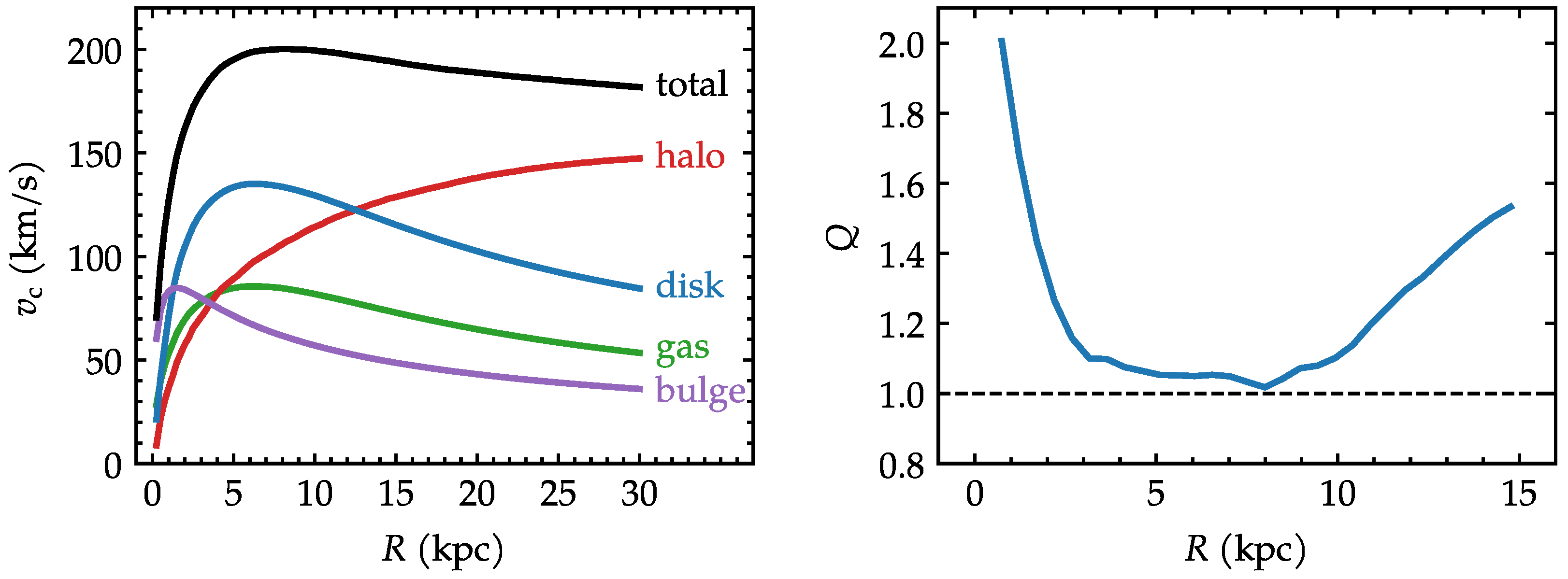
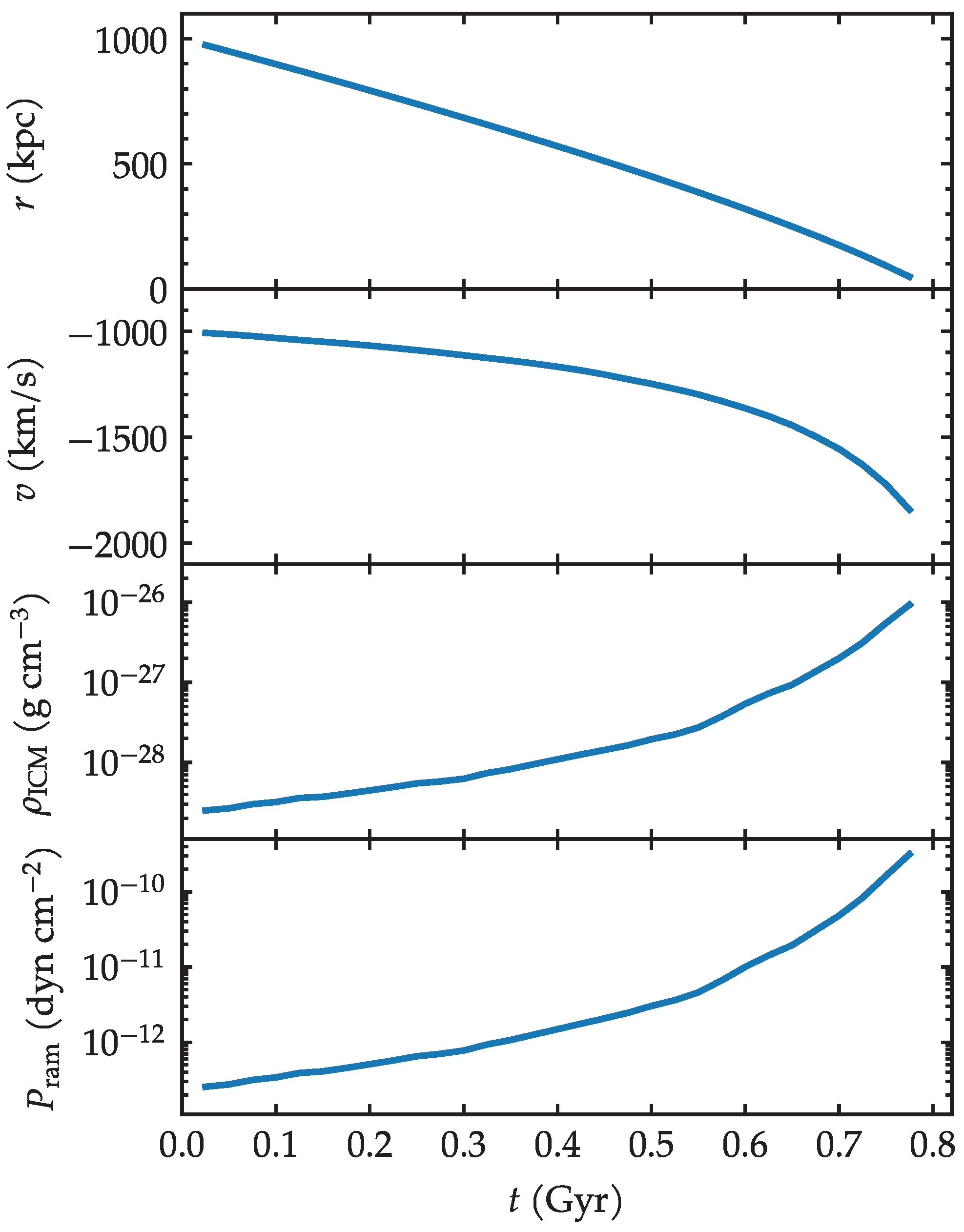

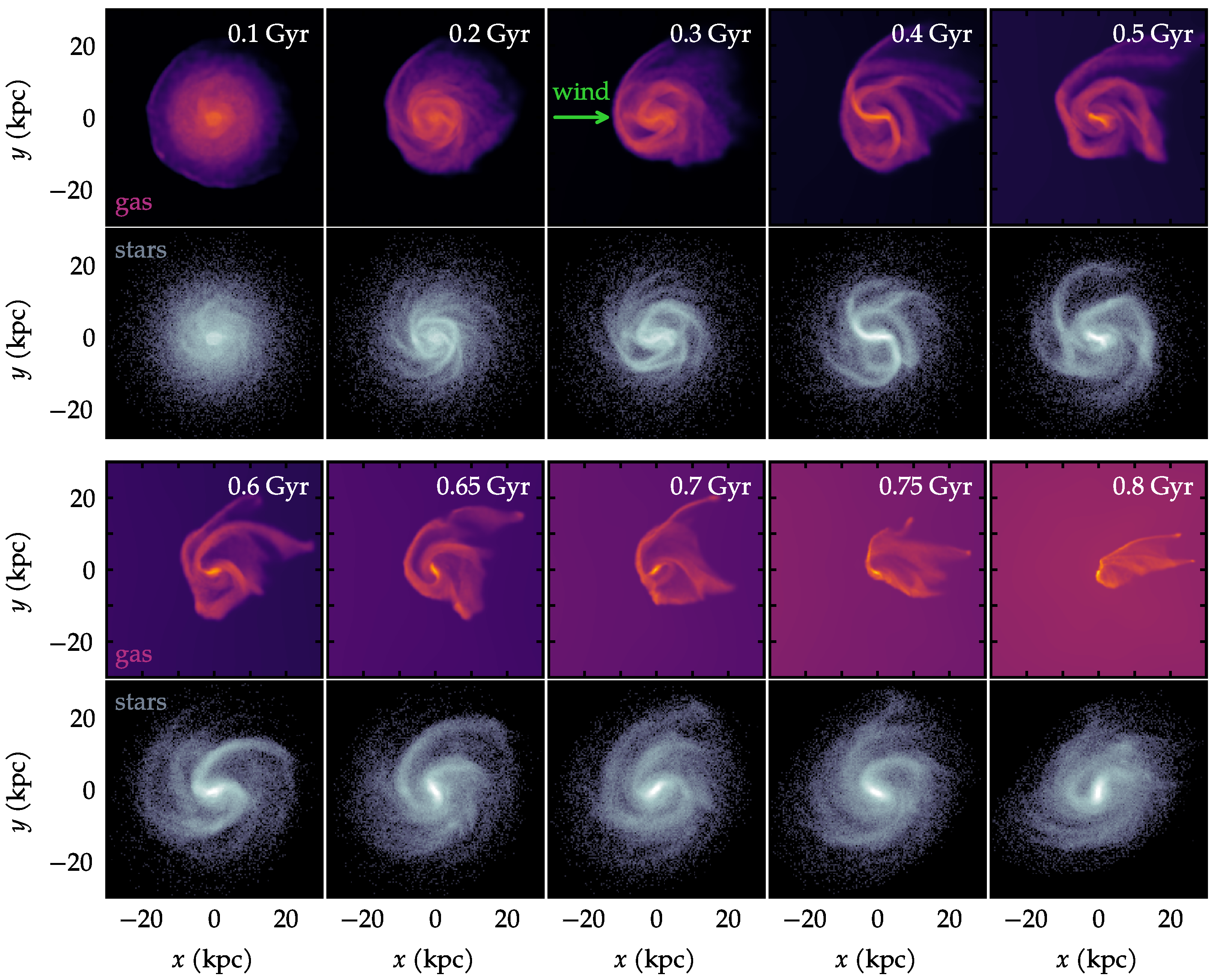

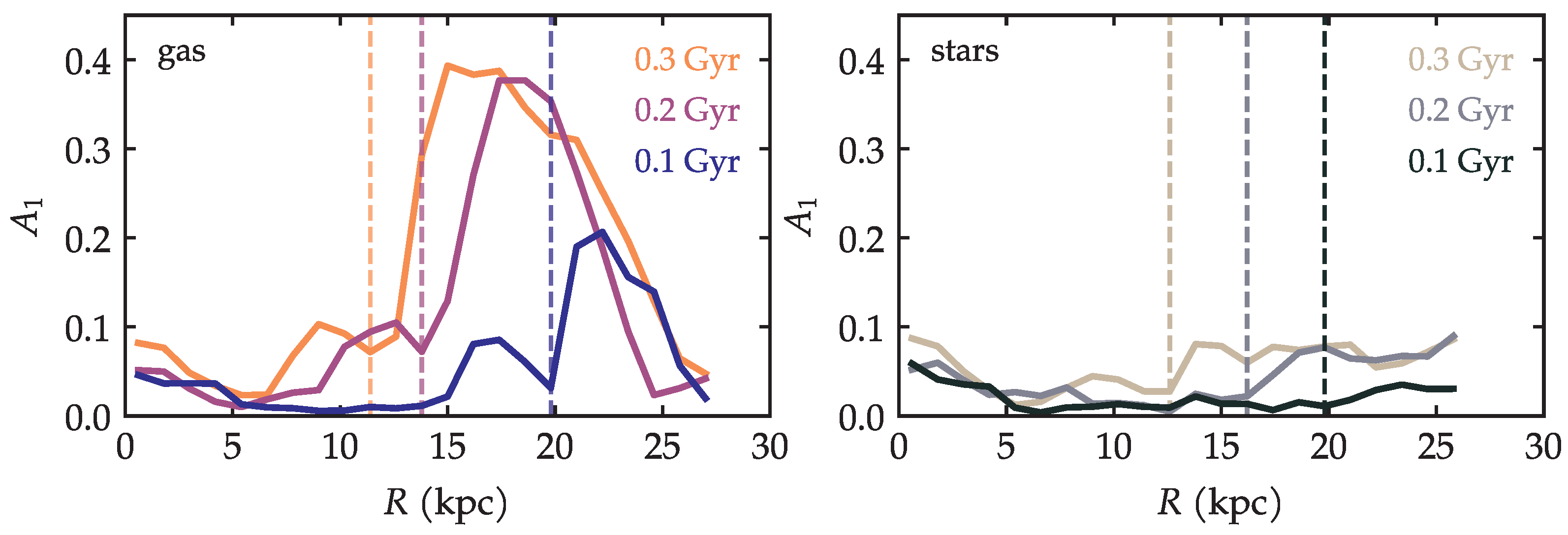
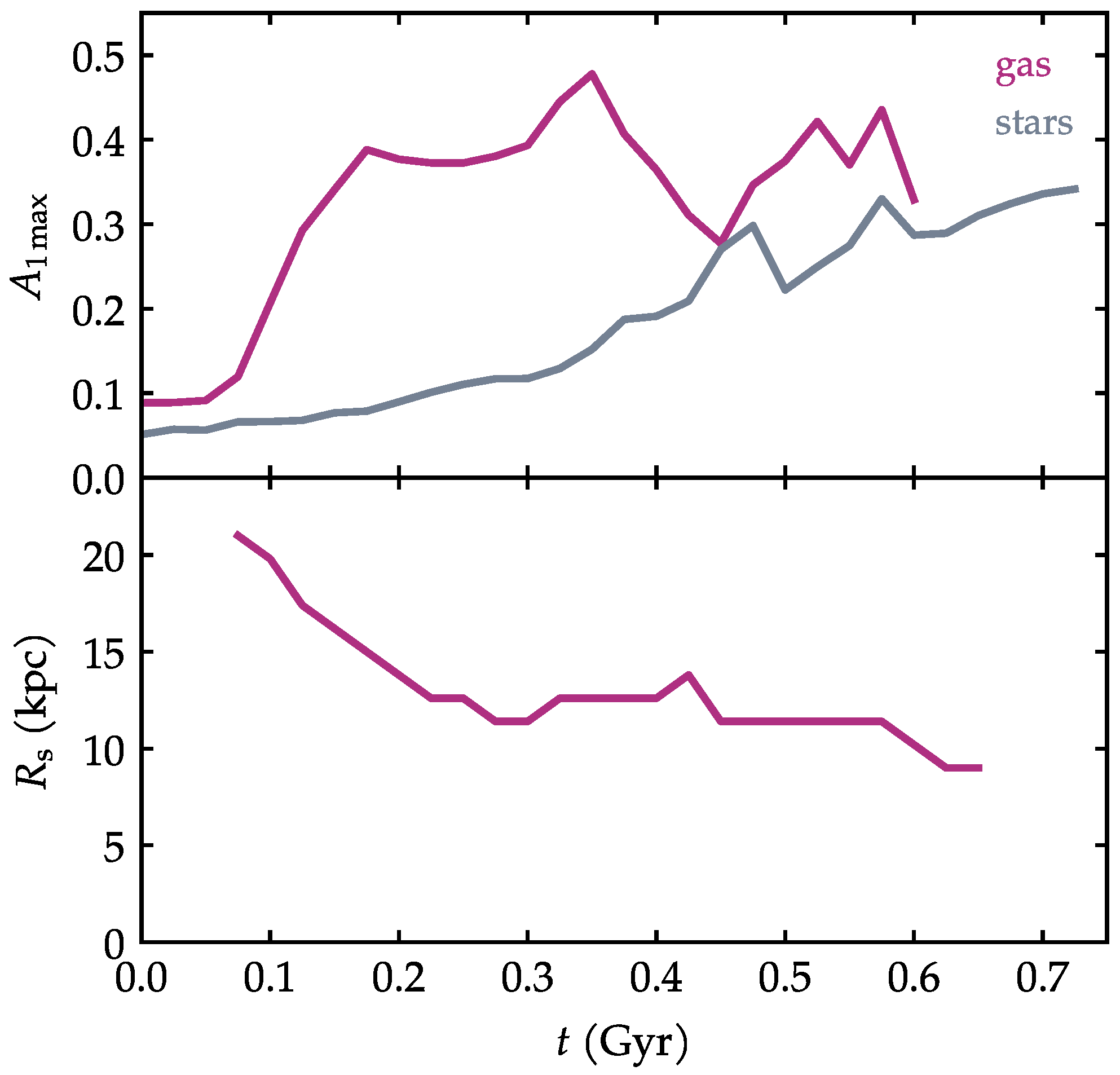

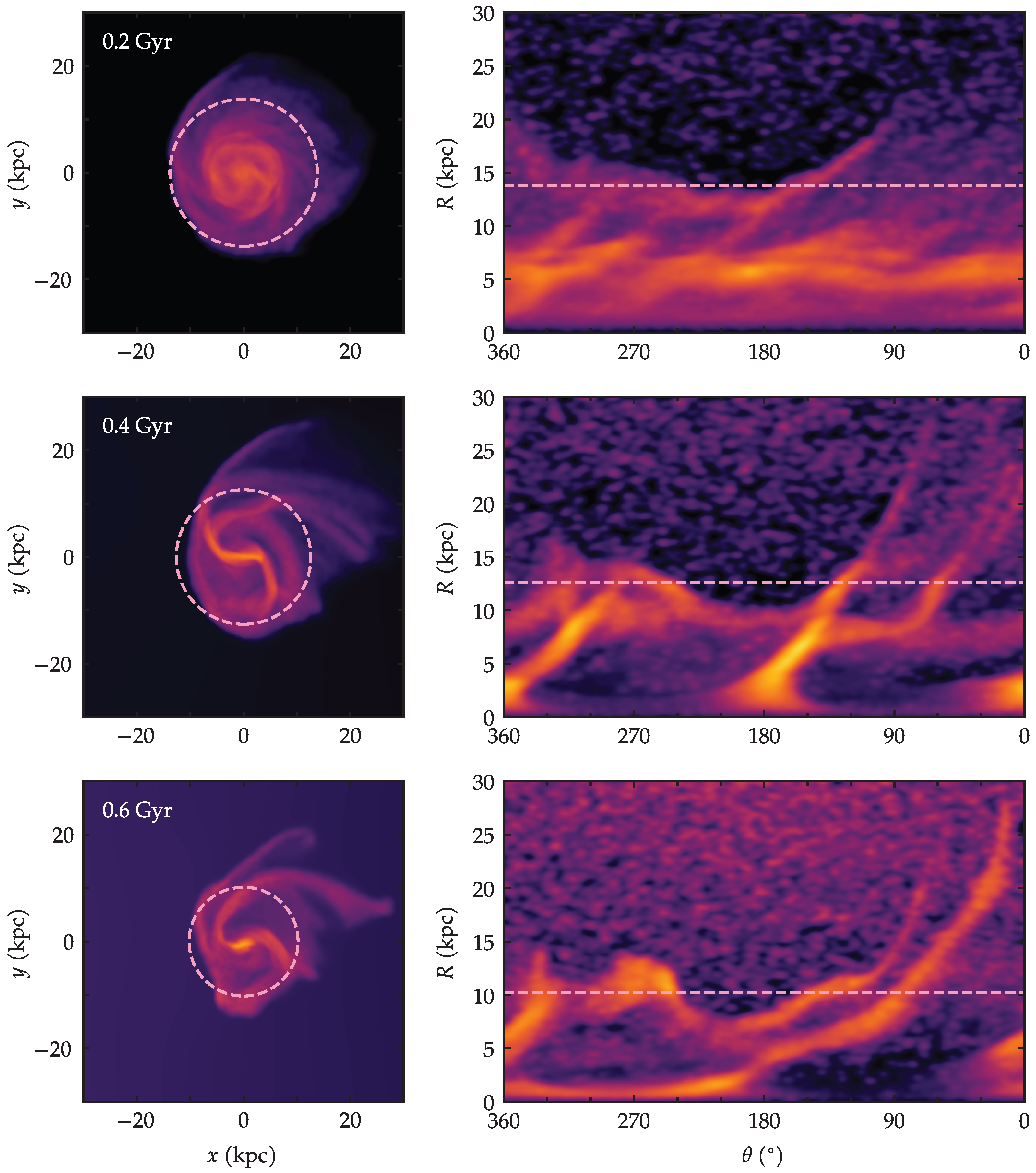
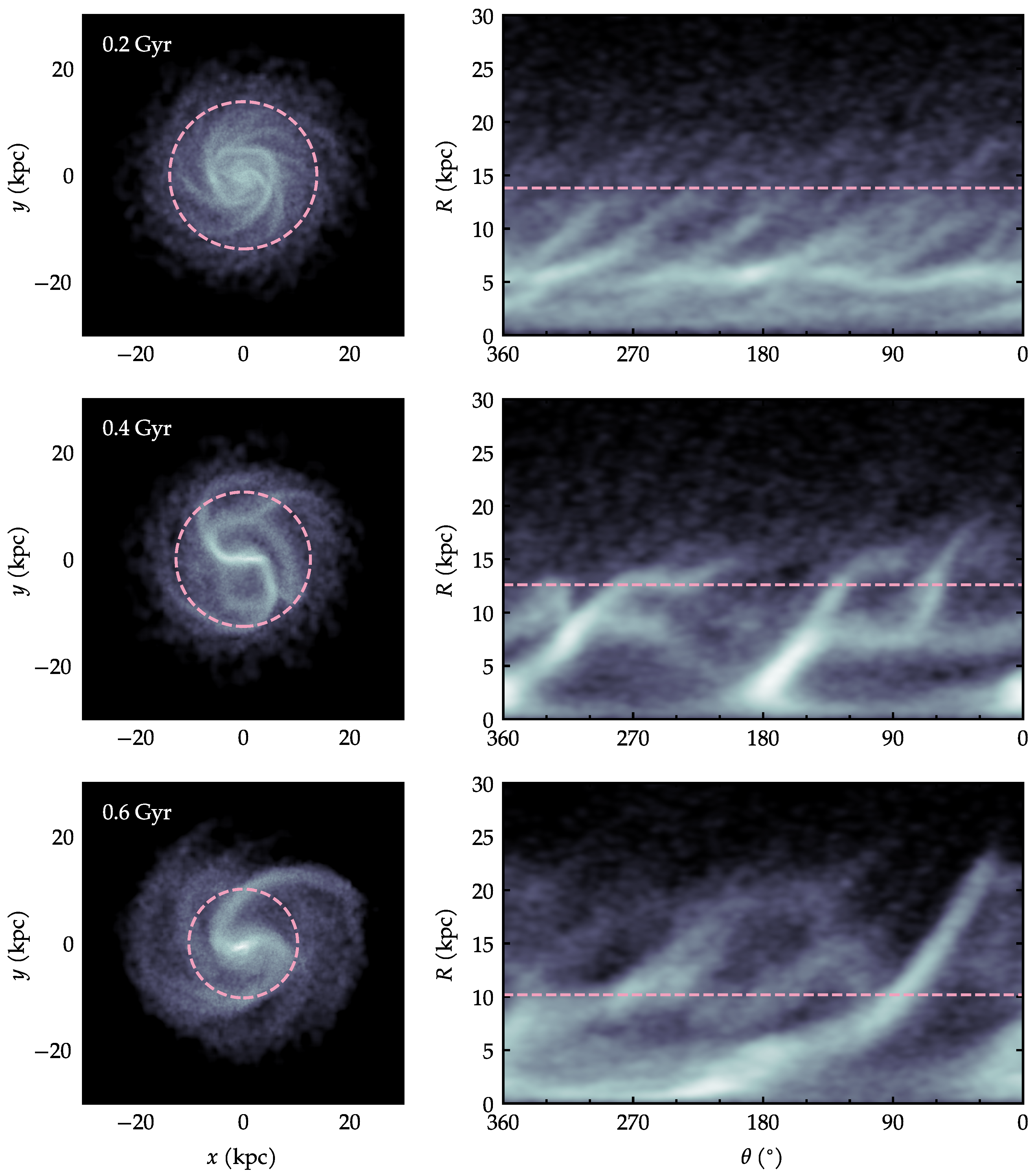
Disclaimer/Publisher’s Note: The statements, opinions and data contained in all publications are solely those of the individual author(s) and contributor(s) and not of MDPI and/or the editor(s). MDPI and/or the editor(s) disclaim responsibility for any injury to people or property resulting from any ideas, methods, instructions or products referred to in the content. |
© 2025 by the authors. Licensee MDPI, Basel, Switzerland. This article is an open access article distributed under the terms and conditions of the Creative Commons Attribution (CC BY) license (https://creativecommons.org/licenses/by/4.0/).
Share and Cite
Machado, R.E.G.; Grinberg, C.F.O.; Mello-Terencio, E.A. Quantifying the Unwinding Due to Ram Pressure Stripping in Simulated Galaxies. Galaxies 2025, 13, 76. https://doi.org/10.3390/galaxies13040076
Machado REG, Grinberg CFO, Mello-Terencio EA. Quantifying the Unwinding Due to Ram Pressure Stripping in Simulated Galaxies. Galaxies. 2025; 13(4):76. https://doi.org/10.3390/galaxies13040076
Chicago/Turabian StyleMachado, Rubens E. G., Caroline F. O. Grinberg, and Elvis A. Mello-Terencio. 2025. "Quantifying the Unwinding Due to Ram Pressure Stripping in Simulated Galaxies" Galaxies 13, no. 4: 76. https://doi.org/10.3390/galaxies13040076
APA StyleMachado, R. E. G., Grinberg, C. F. O., & Mello-Terencio, E. A. (2025). Quantifying the Unwinding Due to Ram Pressure Stripping in Simulated Galaxies. Galaxies, 13(4), 76. https://doi.org/10.3390/galaxies13040076





